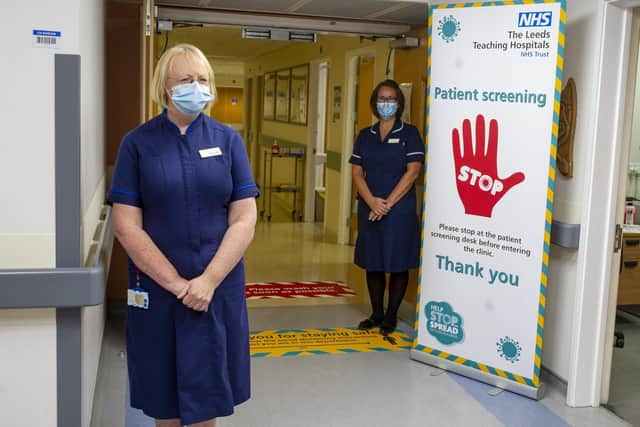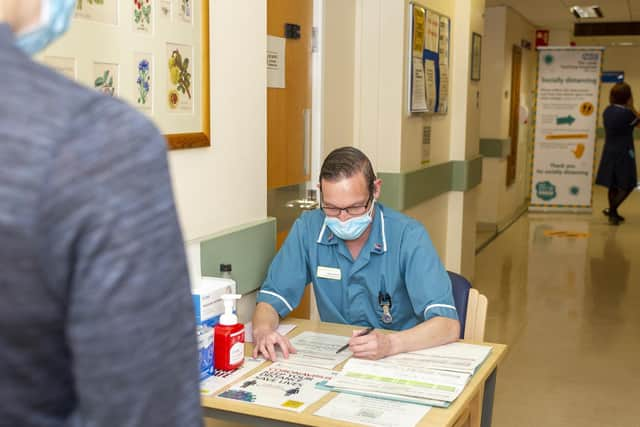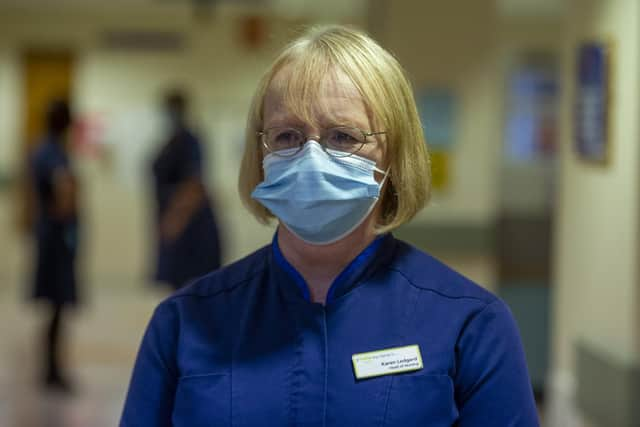From 500 to 30 patients a day - how Leeds outpatients services are catching up after COVID shutdown
and live on Freeview channel 276
With staff diverted, social distancing introduced and sick people even more vulnerable - just how are non-emergency hospital services trying to catch up?
Emma Ryan spent a morning in the Cardio and Neuro outpatients department at Leeds General Infirmary to find out what has become the new normal.
Advertisement
Hide AdAdvertisement
Hide AdOn a pre-coronavirus day the department would be heaving from 8am to 6pm with four reception areas, 30 seats and benches in the waiting areas, 27 rooms in operation to see anything up to 500 patients who could have been waiting hours.


Now, waiting rooms seats have been removed, there are more staff than patients and just 30 a day are being attended to in six rooms.
Karen Ledgard is the head of nursing for outpatients and manages 150 staff members in 16 different outpatient departments over three sites at Leeds General Infirmary, St James's Hospital and Seacroft Hospital.
She said: "Normally patients might be waiting some time but now it is two to three minutes. We were asking them to travel a long distance, to be seen for five minutes but having been sat for a long time. The experience is that they don't have to wait but they have to wait to get to that stage. Each service had to go through a complete waiting list and determine what was deemed to be urgent or acute or able to wait and be put into a different list."


Advertisement
Hide AdAdvertisement
Hide AdPhysical changes have been made to the department. It now operates a one way system starting with a screening desk at the door where each person entering is asked a series of health questions and asked to hand wash and sanitise. Throughout the floor are yellow markers to signal two metres and where to stand when approaching receptions. They have perspex screens around them and clerical staff, like nursing, are kitted out in face masks. There are even two metre spaced arrows on the walls in the staffroom pointing to where nurses can sit during meal breaks.
The department is ready to move into the second phase of a new way of working and that is to try and work through a backlog of appointments. Where possible some are being done via telephone, a health care facility nearer their home or video call. it is only if these measures can't be used that patients are still being asked to come into the LGI for their appointment. There has also been a joint approach between GPs and the hospitals to try and manage those waiting lists, to not pile extra pressure on hospital departments with referrals that can be dealt with at a local practice.
Ms Ledgard added: "If there is no other way because they need an examination or a wound redressing it is only that group being brought in face to face. If we are asking people for an appointment we have gone through a lot of alternatives before we make that decision and we have done all this (reconfiguration of department) to make them feel safe when they do. People are anxious about coming into hospital. We have a real responsibility to make them feel safe."
It is not just patients that have been anxious. At the beginning of the pandemic and while guidelines changed daily - it was a testing time for staff and even those that have been in nursing for more than 40 years.


Advertisement
Hide AdAdvertisement
Hide AdSenior Sister, Judith Shackleton said: "Everybody was wary in the beginning. None of us knew what we were coming into initially. But things have settled down and as soon as staff expressed concern, the team supported each other. The psychology support has been excellent and that was put in for us. We work closely together and everybody has different levels of anxiety so it is about other people's levels of safety and feelings."
Susan Pickard has been a nurse for 42 years. She added: "Staff were scared. I have never seen anything like it in my life and can't see an end to it. I don't see us ever going back to what we call normal."
It is hoped that over the coming weeks the numbers of appointments increased - and that won't be in a 'typical' outpatients setting either.
Ms Ledgard added: "What is going to be normal? That is the next bit. I don't see us ever going back to how it was before - but for the right reasons which is the patients that absolutely need to come in to be seen will do that.
Advertisement
Hide AdAdvertisement
Hide Ad"Outpatients is usually an 8am to 6pm Monday to Friday service but I think we will see more at weekends and past the evenings to allow us to catch up. We still need to see the same number of people just not in that cramped time frame. Some of the changes that have come are the changes that a more modern outpatients centre needed to do."